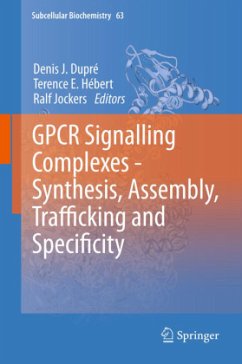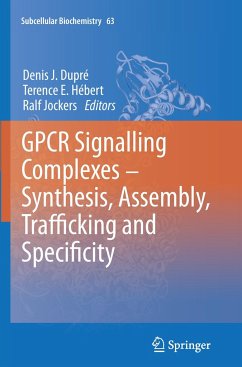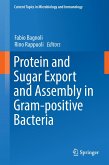This book provides a broad survey of various topics pertaining to G protein coupled receptor (GPCR) assembly into specific signalling complexes, and the regulation of the events leading to this assembly. Throughout this book, we focus on one main area: GPCRs are involved in highly efficient and specific activation of signalling pathways; how are these signalling complexes assembled to generate such specificity? To address this issue, we need to understand how receptors and their signalling partners are synthesized, folded correctly and assembled in order to generate functional complexes. The effects of oligomerization on specificity and efficacy of signal transduction are also discussed. Once receptor complexes are assembled, how are they targeted to different intracellular sites and what controls the trafficking of GPCR signalling complexes? Finally, defects in synthesis, maturation or trafficking can alter functionality of GPCR signalling complexes; how can we manipulate these systems to normalize them functionally? Therefore, the topics to be covered in this book are:
1) Molecular chaperones involved in regulating (quality control) of GPCR synthesis;
2) Assembly of signalling complexes, or subunits of the complex and their organization;
3) GPCR oligomerization;
4) GPCR trafficking;
5) Problems of trafficking: pharmacological chaperones to the rescue. Main Question: G protein coupled receptors are involved in highly efficient and specific activation of signalling pathways. How do GPCR signalling complexes get assembled to generate such specificity? In order to answer this question, we need to understand how receptors and their signalling partners are synthesized, folded and quality-controlled in order to generate functional proteins. Then, we need to understand how each partner of the signalling complex is selected to join a complex, and what makes this assembly possible. GPCRs are known to be able to function as oligomers, what drives the assembly into oligomers and what will be the effects of such organization on specificity and efficacy of signal transduction. Once the receptor complexes are assembled, they need to reach different locations in the cell; what drives and controls the trafficking of GPCR signalling complexes. Finally, defects in synthesis, maturation or trafficking can alter functionality of GPCRs signalling complexes; how can we manipulate the system to make it function normally again? Pharmacological chaperones may just be part of the answer to this question.
1) Molecular chaperones involved in regulating (quality control) of GPCR synthesis;
2) Assembly of signalling complexes, or subunits of the complex and their organization;
3) GPCR oligomerization;
4) GPCR trafficking;
5) Problems of trafficking: pharmacological chaperones to the rescue. Main Question: G protein coupled receptors are involved in highly efficient and specific activation of signalling pathways. How do GPCR signalling complexes get assembled to generate such specificity? In order to answer this question, we need to understand how receptors and their signalling partners are synthesized, folded and quality-controlled in order to generate functional proteins. Then, we need to understand how each partner of the signalling complex is selected to join a complex, and what makes this assembly possible. GPCRs are known to be able to function as oligomers, what drives the assembly into oligomers and what will be the effects of such organization on specificity and efficacy of signal transduction. Once the receptor complexes are assembled, they need to reach different locations in the cell; what drives and controls the trafficking of GPCR signalling complexes. Finally, defects in synthesis, maturation or trafficking can alter functionality of GPCRs signalling complexes; how can we manipulate the system to make it function normally again? Pharmacological chaperones may just be part of the answer to this question.








